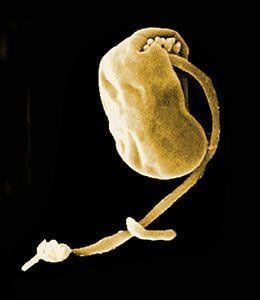Domain Eukaryota | Rank Phylum | |
 | ||
Similar Apusomonas, Filasterea, Bikont, Centrohelid, Loukozoa | ||
The Apusozoa are a phylum comprising several genera of flagellate eukaryotes. They are usually around 5–20 μm in size, and occur in soils and aquatic habitats, where they feed on bacteria. They are grouped together based on the presence of an organic shell or theca under the dorsal surface of the cell.
Contents
The name derives from the Ancient Greek words for footless (ἄπους) and animal (ζῷον).
This phylum may be obsolete or paraphyletic as it appears the opisthokonts emerged within the Apusozoa, with the Apusomonadida as sister clade. The opisthokonts, Apusozoa and Breviate together form the Obazoa clade, a sister clade to the Amoebozoa.
Classification
There are three orders, often treated as separate groups: the apusomonads, ancyromonads, and hemimastigids.
It has been suggested that Mantamonas be classified in Apusozoa.
Characteristics
The apusomonads and ancyromonads have two flagella inserted at right angles, near the anterior of the cell. They move by gliding, with one flagellum trailing along the side and one directed to the anterior. By contrast, hemimastigids cell has multiple flagella, arranged in rows from the anterior of the cell towards the posterior.
The form of the mitochondria varies between the different orders. Among the apusomonads they have tubular cristae, the ancyromonads flat cristae, and the hemimastigids ambiguous or sacculate cristae. This characteristic was originally considered a good indicator of relationships, but is now known to vary even among close relatives.
Relationship to other eukaryotes
On molecular trees, the apusomonads and ancyromonads group together, but their relationship to other eukaryotes is uncertain.
Although it has sometimes been included in the Rhizaria, based on 18S rRNA gene sequencing, it has been concluded that the Apusozoa are not closely related to other Rhizaria.
Cavalier-Smith, in a collaborative paper with Alexandra Stechmann, postulated that Apusozoa belongs in the bikont clade. It may be one of the most divergent bikont lineages.
It has more recently been grouped with the unikonts. It has been suggested that it may be related to the opisthokont group, specifically the Apusmonadida could be the sister clade.
Apusozoa has been rendered paraphyletic by the cladistic inclusion of opisthokont as sister of Apusmonadida. Together they form an as yet unnamed clade which is sister to the Apusozoan Breviatea clade. Together these form the Obazoa.
